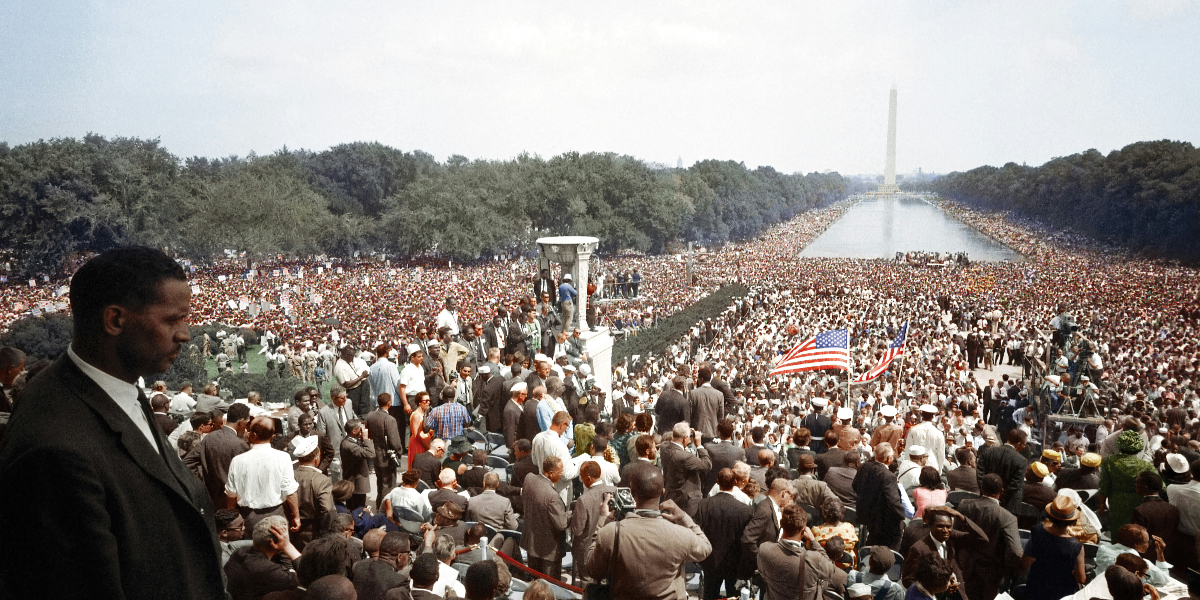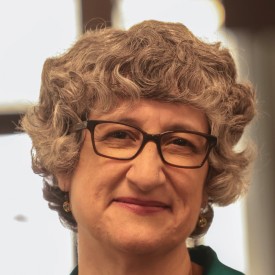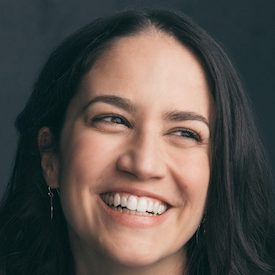Rita Omokha is an award-winning Nigerian American journalist. Her writing on politics and race has been featured on CNN and in The Washington Post, Elle, Glamour, New York Magazine, Wired, and Vanity Fair, among other publications. She is an adjunct professor at Columbia University’s Graduate School of Journalism.
What’s the big idea?
When we live inside a bubble, we wear blinders to the many perspectives around us. It is of vital societal importance to be curious and intentional about the many life experiences in and outside of our communities. History has many activists who model this type of intentional thinking, and their campaigns show a blueprint for how to call upon the past for the sake of future progress.
Below, Rita shares five key insights from her new book, Resist: How a Century of Young Black Activists Shaped America. Listen to the audio version—read by Rita herself—in the Next Big Idea App.

1. Intentionality is the antidote to insulation.
I grew up in a Nigerian bubble in the South Bronx. Outside our apartment was this big world, but inside was our mini-Nigeria. We played our music, ate our foods, and spoke our language. It was safe, but it was limited. It wasn’t until I tested out of my zone public school that my world began to crack open. Before that, I simply didn’t know what I didn’t know.
By the time I got to college, I began intentionally learning about the country I was in. About the people—especially Black Americans—who had looked after my brothers and me as latchkey kids when my mom worked her three jobs. About why people who looked like me were perceived differently than the white people I was integrated with in elite programs across New York City. About what really led to the stop, arrest, and subsequent deportation of my eldest brother. About race, racism, and the rest.
My intentionality led me deeper into the history of it all. That intentionality led me to travel across the country in 2020 after George Floyd was killed. I ventured on a reporting trip that spanned 30 states in 32 days. I was curious to know why race in America had been so pervasive and a sickness that permeates our society. I wanted to understand the systemic roots of racism, to hear the stories of those affected, and to grapple with the complexities of identity and belonging.
I discovered that people’s inability to expand their worldviews by moving beyond their immediate radius can create a cycle of unintended ignorance and misunderstanding. When people are confined to a singular perspective—be that geography, culture, or choice—they risk perpetuating outdated beliefs and attitudes. Insularity stifles personal growth and fuels societal divisions.
To the people steeped in the insulation, it’s their truth—just like it was mine in our Nigerian bubble. This reminds me of an older white couple I met in Kenosha, Wisconsin. They were in their 70s. We talked about their perception of Black America. It was candid, respectful, and eye-opening. Our perspectives throughout our lives had shaped who we were; they had shaped our thinking patterns—mine by hardship and survival, theirs by coming up during a time when they were told white Americans were inherently superior. Yet, we remained open to conversation. Despite our clear differences, there was an undertone of curiosity and desire to understand the other.
There’s a certain level of intentionality needed to have such conversations. That kind of intentionality is what I saw in the young activists I studied. In the face of a society that constantly sought to confine them, they engaged with their world in rebellion. Activists like the Bates Seven, made up of one Black and six white NYU students, who stood up for a Black football player sidelined because of his race. Their intentional thinking led them to challenge the systems that reinforced the persecution of an other. Their hunger for righteousness fueled a curiosity that exceeded fear and apathy.
2. Immigrants’ welcome to America traces back to young Black activists.
My existence in this country, like that of many immigrants, would not be possible if not for the activists who paved the way for our rights and broader inclusion. Young Black activists have historically been at the forefront of expanding democratic ideals to include marginalized groups.
Take the Immigration and Nationality Act of 1965. That legislation abolished national-origin quotas, dismantling segregationist laws and racial quotas that prioritized European immigrants. It opened the doors for immigrants from places like Africa, Asia, and Latin America. This is what led my mom to America, as she later benefited from the Immigration Act of 1992. She was hand-selected to come to America during the nursing shortage of the nineties. In a literal sense, I am who I am today because of those who came before me in this country.
“My existence in this country, like that of many immigrants, would not be possible if not for the activists who paved the way for our rights and broader inclusion.”
Such iterations of the Immigration Act were made possible after the efforts of the Civil Rights Movement, where young leaders like Bob Moses, John Lewis, and Diane Nash from the Student Nonviolent Coordinating Committee worked tirelessly to dismantle systemic barriers and set the stage for movements advocating for the immigrant rights many of us continue to revel in today.
From championing civil liberties to pushing for inclusive policies, they’ve always shown how a democracy must be accessible to all, regardless of race, citizenship status, or national origin. Their fight underscores the idea that democracy must continuously protect the rights of those on the margins and that immigrants are vital to reshaping the democratic promise.
3. Education is the pathway to freedom.
There’s a passage from the Bible that forever remains imprinted in my mind. It’s in Hosea, and it says, “My people perish for lack of knowledge.” I love that verse because it succinctly captures the essence of knowing. Of wisdom. Of curiosity. Of trying to seek out truth in a world often clouded by ignorance or indifference. That verse reminds me that knowledge is not just a luxury—it’s a necessity. It empowers us to question, to learn, and to grow.
Barbara Johns is a perfect example of that verse in action. In 1951, Barbara was a high school student in Virginia who took a stand against the awful conditions in her segregated school. She organized a student strike, highlighting how crucial access to quality education is for social mobility. Her efforts led to the landmark success of the Brown case; her county, Prince Edward County, had the most plaintiffs in one of the five consolidated cases that went to the Supreme Court under Brown.
In the face of overwhelming adversity, she understood that education was about collective empowerment. Her strike wasn’t just about better facilities; it was about affirming the dignity and potential of Black students in a system that sought to diminish them. By taking a stand, she made it clear that without access to quality education, entire communities could perish.
Barbara’s plea was that every child deserves a fair chance regardless of race or background. That remains true today. While schools remain socially segregated—where people are quick to assess intellectual potential based on zip code—quality education is still the bedrock upon which we build a more just society. Barbara’s legacy serves as a powerful reminder that when we invest in education, we invest in the future of our democracy.
4. History is a guide, not a blueprint.
History is an instructive foundation. It allows us to understand patterns, avoid previous mistakes, and make informed decisions about the future. The adage that “history doesn’t repeat itself, but it rhymes” powerfully encapsulates this sentiment. It reveals how deeply entrenched today’s inequities are in the historical wrongs that shaped our society.
“The imprints from the fight of yesteryear remain the springboard for collective action.”
Yet, there’s a tendency to overlook history’s warnings, which can lead to repeated mistakes. From redlining to mass incarceration, many injustices have simply shifted form. But the imprints from the fight of yesteryear remain the springboard for collective action. Think about the galvanization in 2020 after the killing of George Floyd. That was from the playbook of Ella Baker, Barbara Johns, and Charlie Cobb, from the Black Power Movement to the Civil Rights Movement.
All movements, then and now, involved young Black activists and their allies fighting for basic rights. They challenged society to address historical legacies in their present-day iterations. They showed how failing to reckon with historical truths led to today’s ongoing inequalities. So, no, history does not repeat itself. We’ve just neglected its lessons. History is meant to be our guide. It is meant to be called upon.
5. Some wisdom can only be gleaned from pain.
A recurring theme from my research is that from pain, desperation, and continued subjugation, my case studies decided to stand up and do something. Their stories show that life’s trials often serve as teachers, shaping our understanding and resilience in ways comfort never could.
Consider the generations who endured the oppressive realities of Jim Crow laws. Their oppressive upbringing, marked by undue hardship, was a form of pruning, removing the excess, and revealing the core of their strength and character. That’s what powered the fight of those who said enough is enough—the thinking that suffering can serve as a crucible for growth.
For those subjected to the relentless grind of oppression, the decision to resist often comes from a place where dignity outweighs fear, where survival demands not only endurance but also action. This realization, born from pain, drives people to reclaim their humanity and assert their right to exist freely and fully. Those who have navigated the complexities of a painful past often emerge with a deeper appreciation for the fragility and beauty of life.
To listen to the audio version read by author Rita Omokha, download the Next Big Idea App today:
































